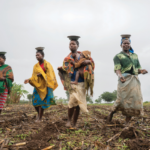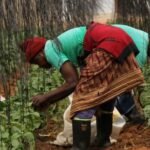By Murimi Gitari, July 5, 2023, A new research article in the journal Food Policy, by the International Food Policy Research Institute (IFPRI) provides compelling evidence that, within agriculture, the dairy sector has tremendous potential to improve nutrition in early childhood.
Stunting, a form of chronic under nutrition, affects 150 million children worldwide. While nutrition interventions have been shown to reduce stunting, experts have long concluded that other sectors, like agriculture, need to lift more weight.
Dairy’s nutritional properties have long been understood, including its high-quality proteins and wide range of micronutrients crucial for both physical and cognitive development. However, no previous study has demonstrated, at the global level, the potential for growth in dairy consumption to reduce national stunting rates in line with Sustainable Development Goal 2.
This study addresses this gap by analyzing a large cross-country panel of 91 countries. The researchers find that a 10% increase in per capita milk consumption predicts a 0.7 percentage point reduction in stunting prevalence. “The relationship between milk consumption and stunting reduction is a really strong one,” says Derek Headey, senior research fellow with the International Food Policy Research Institute, “and suggests we should really ramp up investments in dairy if we’re serious about reducing stunting.”
The researchers acknowledge longstanding concerns about dairy products. Cow’s milk is a complement to breastmilk, not a substitute, and they argue that nutrition education campaigns should promote exclusive breastfeeding in the first 5 months after birth, and then an appropriate mix of breastfeeding and complementary feeding – including dairy – from 6 months onwards.
“As for climate change impacts, the dairy sector actually produces a lot of high-quality protein relative to its greenhouse gas emissions,” says Beliyou Haile, former IFPRI research fellow, “so while there is a climate cost, there’s also a large nutritional benefit to dairy production.” The authors note emissions from dairy are much lower than beef, despite the two sectors often being lumped together in climate change discussions. Moreover, efficiency improvements in dairy production could simultaneously reduce emissions and make dairy products more affordable for the poor.
Lactose intolerance is another barrier they discuss, though it primarily only affects adult populations in countries with no history of dairy consumption, rather than young children. “Vietnam has no dairy traditions at all, but has been able to rapidly increase consumption of dairy products among young children, and reduce stunting,” notes Headey, “going from zero to hero in just a few decades.”
The study’s findings provide compelling arguments for policymakers, public health officials, and nutrition experts to prioritize context-specific dairy development strategies that rely on the right mix of local dairy sector interventions and more consumer-oriented trade policies. By doing so, countries can make significant progress in redressing stunting and improving the diets of malnourished populations worldwide.







